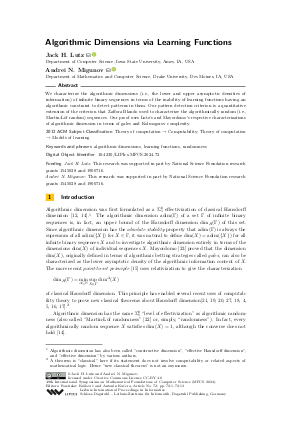Algorithmic Dimensions via Learning Functions
Authors
Jack H. Lutz  ,
Andrei N. Migunov
,
Andrei N. Migunov 
-
Part of:
Volume:
49th International Symposium on Mathematical Foundations of Computer Science (MFCS 2024)
Part of: Series: Leibniz International Proceedings in Informatics (LIPIcs)
Part of: Conference: Mathematical Foundations of Computer Science (MFCS) - License:
 Creative Commons Attribution 4.0 International license
Creative Commons Attribution 4.0 International license
- Publication Date: 2024-08-23
File

PDF
LIPIcs.MFCS.2024.72.pdf
- Filesize: 0.68 MB
- 13 pages
Document Identifiers
Subject Classification
ACM Subject Classification
- Theory of computation → Computability
- Theory of computation → Models of learning
Keywords
- algorithmic dimensions
- learning functions
- randomness
Metrics
- Access Statistics
-
Total Accesses (updated on a weekly basis)
0PDF Downloads0Metadata Views
Abstract
We characterize the algorithmic dimensions (i.e., the lower and upper asymptotic densities of information) of infinite binary sequences in terms of the inability of learning functions having an algorithmic constraint to detect patterns in them. Our pattern detection criterion is a quantitative extension of the criterion that Zaffora Blando used to characterize the algorithmically random (i.e., Martin-Löf random) sequences. Our proof uses Lutz’s and Mayordomo’s respective characterizations of algorithmic dimension in terms of gales and Kolmogorov complexity.
Cite As Get BibTex
Jack H. Lutz and Andrei N. Migunov. Algorithmic Dimensions via Learning Functions. In 49th International Symposium on Mathematical Foundations of Computer Science (MFCS 2024). Leibniz International Proceedings in Informatics (LIPIcs), Volume 306, pp. 72:1-72:13, Schloss Dagstuhl – Leibniz-Zentrum für Informatik (2024)
https://doi.org/10.4230/LIPIcs.MFCS.2024.72
BibTex
@InProceedings{lutz_et_al:LIPIcs.MFCS.2024.72,
author = {Lutz, Jack H. and Migunov, Andrei N.},
title = {{Algorithmic Dimensions via Learning Functions}},
booktitle = {49th International Symposium on Mathematical Foundations of Computer Science (MFCS 2024)},
pages = {72:1--72:13},
series = {Leibniz International Proceedings in Informatics (LIPIcs)},
ISBN = {978-3-95977-335-5},
ISSN = {1868-8969},
year = {2024},
volume = {306},
editor = {Kr\'{a}lovi\v{c}, Rastislav and Ku\v{c}era, Anton{\'\i}n},
publisher = {Schloss Dagstuhl -- Leibniz-Zentrum f{\"u}r Informatik},
address = {Dagstuhl, Germany},
URL = {https://drops.dagstuhl.de/entities/document/10.4230/LIPIcs.MFCS.2024.72},
URN = {urn:nbn:de:0030-drops-206282},
doi = {10.4230/LIPIcs.MFCS.2024.72},
annote = {Keywords: algorithmic dimensions, learning functions, randomness}
}
Author Details
Funding
- Lutz, Jack H.: This research was supported in part by National Science Foundation research grants 1545028 and 1900716.
- Migunov, Andrei N.: This research was supported in part by National Science Foundation research grants 1545028 and 1900716.
References
-
Krishna B. Athreya, John M. Hitchcock, Jack H. Lutz, and Elvira Mayordomo. Effective strong dimension in algorithmic information and computational complexity. SIAM journal on computing, 37(3):671-705, 2007.

-
Patrick Billingsley. Probability and measure. Wiley-Interscience, 1995.

-
Thomas R. Cover and Joy A. Thomas. Elements of Information Theory. John Wiley & Sons, Inc., 2006.

-
Rod Downey and Denis R Hirschfeldt. Algorithmic randomness. Communications of the ACM, 62(5):70-80, 2019.

-
Rod Downey and Denis R Hirschfeldt. Computability and randomness. Notices of the American Mathematical Society, 66(7):1001-1012, 2019.

-
Rodney G. Downey and Denis R. Hirschfeldt. Algorithmic Randomness and Complexity. Springer Science & Business Media, 2010.

-
E Mark Gold. Language identification in the limit. Information and control, 10(5):447-474, 1967.

-
F Hausdorff. Dimension und äußeres maß. Mathematische Annalen, 79:157-179, 1919.

-
John M Hitchcock. Gales suffice for constructive dimension. Information Processing Letters, 86(1):9-12, 2003.

-
Sanjay Jain, Daniel Osherson, James S Royer, Arun Sharma, et al. Systems that Learn: An Introduction to Learning Theory. MIT press, 1999.

-
Leon G Kraft. A device for quantizing, grouping and coding amplitude modified pulses. Master’s thesis, Cambridge, MA, 1949.

-
Jack H Lutz. Gales and the constructive dimension of individual sequences. In International Colloquium on Automata, Languages, and Programming, pages 902-913. Springer, 2000.

-
Jack H Lutz. Dimension in complexity classes. SIAM Journal on Computing, 32(5):1236-1259, 2003.

- Jack H. Lutz. The dimensions of individual strings and sequences. Information and Computation, 187(1):49-79, 2003. URL: https://doi.org/10.1016/S0890-5401(03)00187-1.
-
Jack H Lutz and Neil Lutz. Algorithmic information, plane Kakeya sets, and conditional dimension. ACM Transactions on Computation Theory (TOCT), 10(2):1-22, 2018.

-
Jack H Lutz and Neil Lutz. Who asked us? How the theory of computing answers questions about analysis. In Complexity and Approximation, pages 48-56. Springer, 2020.

-
Jack H Lutz and Elvira Mayordomo. Algorithmic fractal dimensions in geometric measure theory. In Handbook of Computability and Complexity in Analysis, pages 271-302. Springer, 2021.

- Jack H Lutz, Renrui Qi, and Liang Yu. The point-to-set principle and the dimensions of Hamel bases. Computability, 13(2):105-112, 2024. URL: https://doi.org/10.3233/COM-210383.
-
Neil Lutz. Fractal intersections and products via algorithmic dimension. ACM Transactions on Computation Theory (TOCT), 13(3):1-15, 2021.

-
Neil Lutz and Donald M Stull. Projection theorems using effective dimension. In 43rd International Symposium on Mathematical Foundations of Computer Science (MFCS 2018), 2018.

-
Neil Lutz and Donald M Stull. Bounding the dimension of points on a line. Information and Computation, 275:104601, 2020.

-
Per Martin-Löf. The definition of random sequences. Information and Control, 9(6):602-619, 1966.

-
Elvira Mayordomo. A Kolmogorov complexity characterization of constructive Hausdorff dimension. Information Processing Letters, 84(1):1-3, 2002.

-
Daniel Osherson and Scott Weinstein. Recognizing strong random reals. The Review of Symbolic Logic, 1(1):56-63, 2008.

-
Daniel N Osherson, Michael Stob, and Scott Weinstein. Systems that Learn: An Introduction to Learning Theory for Cognitive and Computer Scientists. The MIT Press, 1986.

- Claus-Peter Schnorr. A unified approach to the definition of random sequences. Mathematical Systems Theory, 5(3):246-258, 1971. URL: https://doi.org/10.1007/BF01694181.
-
Theodore Slaman. Kolmogorov complexity and capacitability of dimension. Report No. 21/2021. Mathematisches Forschungsinstitut Oberwolfach, 2021.

-
Tomasz Steifer. A note on the learning-theoretic characterizations of randomness and convergence. The Review of Symbolic Logic, pages 1-16, 2021.

-
Dennis Sullivan. Entropy, Hausdorff measures old and new, and limit sets of geometrically finite Kleinian groups. Acta Mathematica, 153(1):259-277, 1984.

-
Claude Tricot. Two definitions of fractional dimension. In Mathematical Proceedings of the Cambridge Philosophical Society, volume 91, pages 57-74. Cambridge University Press, 1982.

-
Jean Ville. Etude critique de la notion de collectif. Gauthier-Villars Paris, 1939.

-
Francesca Zaffora Blando. A learning-theoretic characterisation of Martin-Löf randomness and Schnorr randomness. The Review of Symbolic Logic, 14(2):531-549, 2021.

